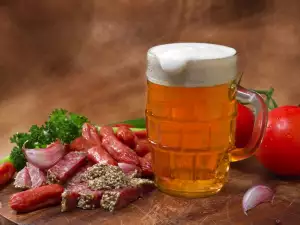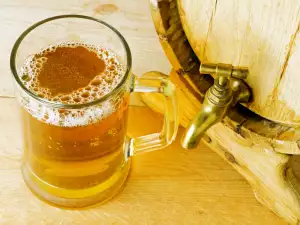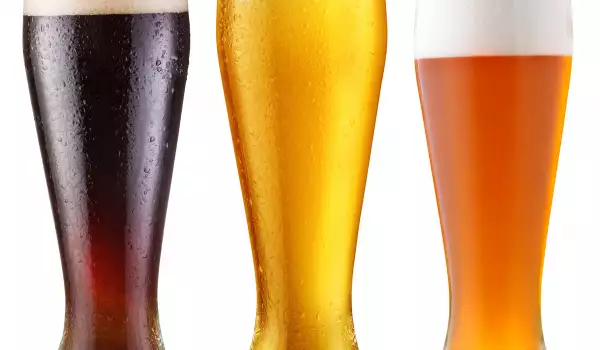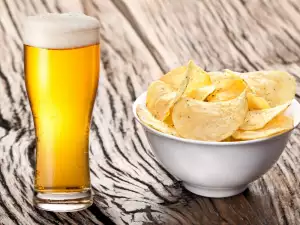Beer is considered to be the oldest alcoholic beverage in the world. Today, it is the third most popular drink after coffee and tea. It is low in alcohol, and it is usually made from water, malted barley, hops and fermenting yeast. Often, however, in it are added other flavors or sweeteners. You can also add other flavors using herbs and fruits.
History of beer
The first written document which shows the consumption and the making of beer is from the times of the Sumerians, the 4th century BC Sumerian beer was called sikaru. Even in those times, the principle of production of beer is based on the fermentation of barley. Residents of Babylon continued this tradition by grinding barley flour and making a cake in the shape of bread.
This makes it easier to transport. In fact, the production of beer and bread are deeply connected and start at the same time. Custom requirements during the first month after the wedding, the bride's father are brother have beer every day. Tradition demanded from the groom to see that beer can change, but not the woman.
Getting beer happened by breaking this mold and diping it in water to ensure long fermentation. Barley was one of the most popular cultures and each family makes its beer from a special recipe. Family gradually gave way to professional production. At the end of the 11th century, they began to add hops, and so got the taste we know today.

Beer gets most of its flavor mostly from hops, which is a plant with flowers that resemble cones more than daisies. Alcohol came from barley germinates and is then put in water to extract the sugar from it. This sugar is the basis for the development of tiny single-celled yeasts that "bloom" that produce alcohol.
The highest consumption of beer is in Ireland - 160 liters per head, followed by the Czech Republic and Germany.
Composition of beer
Beer contains many beneficial substances such as magnesium, potassium, phosphorus, iron, vitamin B and H, amino acids and others. Beer contains about 60 proteins, 40 of which are formed by yeast. It is believed that these proteins play a key role in the formation of the foam on the beer.
Beer contains no cholesterol and is low in sugars. Barley is a rich and easily assimilated by the body fiber that improves normal bowel function. Beer is a rich source of silicone, an important strength of human bones.
Hops not only add flavor but also bitter taste to beer and is a great source of antioxidants. It is believed that it is much more effective in the prevention of many diseases than red wine and green tea. Dark beer is twice as high in antioxidants as light.

Values per 100 g of beer

Calories 29
Calories from fat 0
Total fat 0
Saturated fat 0
Polyunsaturated Fat 0
Monounsaturated fat 0
Cholesterol 0
Sodium 4 mg
Potassium 21 mg
Total Carbohydrate 1.64 g
Fibre 0
Sugars 0.09 g
Protein 0.24 g
95 ml of water
Calcium 4 mg
Phosphorus 12 mg
Magnesium 5 mg
Selection and storage of beer
Choose beer in sealed bottles /glass and plastic/ which have a clearly articulated manufacturer label and expiration date. Keep the beer in a cool dark room, and when it's open - in the fridge. Do not leave beer for long after opening its cap because with the advent of air, it loses its carbonation and qualities.
Once you open a bottle of beer, it can be stored longer, if properly sealed- can be stored for 2 days. Light is the biggest killer of beer, because the hops are photosensitive compounds known as isohumulous.
In long exposure to light, a reaction is formed. Isohumulons separate compounds present in the glands of the skunk. This is why beer should be stored in a green and brown bottles.
Beer in cooking
Beer as a beverage is a delight, but its use in culinary dishes is from very unique creations. It is used to prepare a variety of dishes, sauces and marinades. If you soak chicken in beer, before grilling, it will become incredibly tender. The same goes for roasting pork.
Beer combines very well with fried potatoes and a variety of hot entrees. With meat, it goes great and dark beer is a great drink for the winter. In the hot summer months, beer consumption is highest, and its cooling effect makes it one of the most consumed beverages.

Benefits of Beer
Even with the initial production of beer, people discovered its benefits and healing properties. Ancient Sumerian physicians prescribe it to their patients for several problems, like drinking warm beer for a toothache.
In the Middle Ages, beer was applied as a means of bringing out stones from the kidney to treat physical and mental exhaustion. When their legs are tired, people rub their feet with beer. Some doctors previously treated respiratory diseases with beer.
Among the fairer sex beer had fame as a rejuvenating agent if the skin is treated. It has rejuvenating properties, if used on the skin. Some doctors believed that beer is a cure for cholera because germs died after several hours in beer. Professor Koch, who was the discoverer of the cause of cholera, told his colleagues that he hypothesized that beer can cure cholera.
It is proven that the bones of women who regularly sip beer are strong and healthy, and the danger to become ill from osteoporosis to them is minimal. It is believed that the high level of silicone in beer slows down the thinning of bones. Phytoestrogens in the beverage maintain healthy bones.
Experts are adamant that beer contains substances that stimulate the immune system and hormone of happiness. Some active substances of hops in beer have a calming, analgesic and sedative action. Studies show that people who drink beer are more positive and more vibrant than abstainers. Beer is also appropriate for anemic and recovering from illness, people.
It was found that because of the low content of calcium and magnesium, beer protects against gallstones. It is believed that it helps against Parkinson’s disease. Other studies have shown that consumption of beer protects the body from the accumulation of toxins and radiation.
The slightly alcoholic beverage helps to facilitate discharge of toxins from the body. Beer purifies the body of carcinogens, thereby reducing the risk of cancer.

Dangers of beer
Studies show that consumption of beer with peanuts and other nuts is a combination that should be avoided. Peanuts contain vitamin C, E, PP and minerals such as sodium, potassium, calcium, manganese, phosphorus and iron. Beer and any other alcohol act detrimental to these nutrients, leading to food absolutely unnecessary burdening the body. Generally, it is a widespread myth that beer leads to obesity.
To eventual weight gain is from excessive consumption of beer with various snacks, chips, nuts, meats, etc. Gain in this case is the result of slow metabolic processes of food and beverages.
Beer does not contain as many calories, but the average person is not satisfied with just one pint. Beer does not contribute to the "beer" belly, it comes from overeating rather than using beer. However, while with less alcohol, beer is alcohol, and as such, do not overdo it.


















Comments